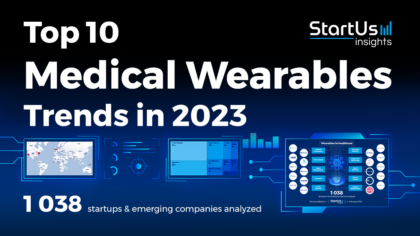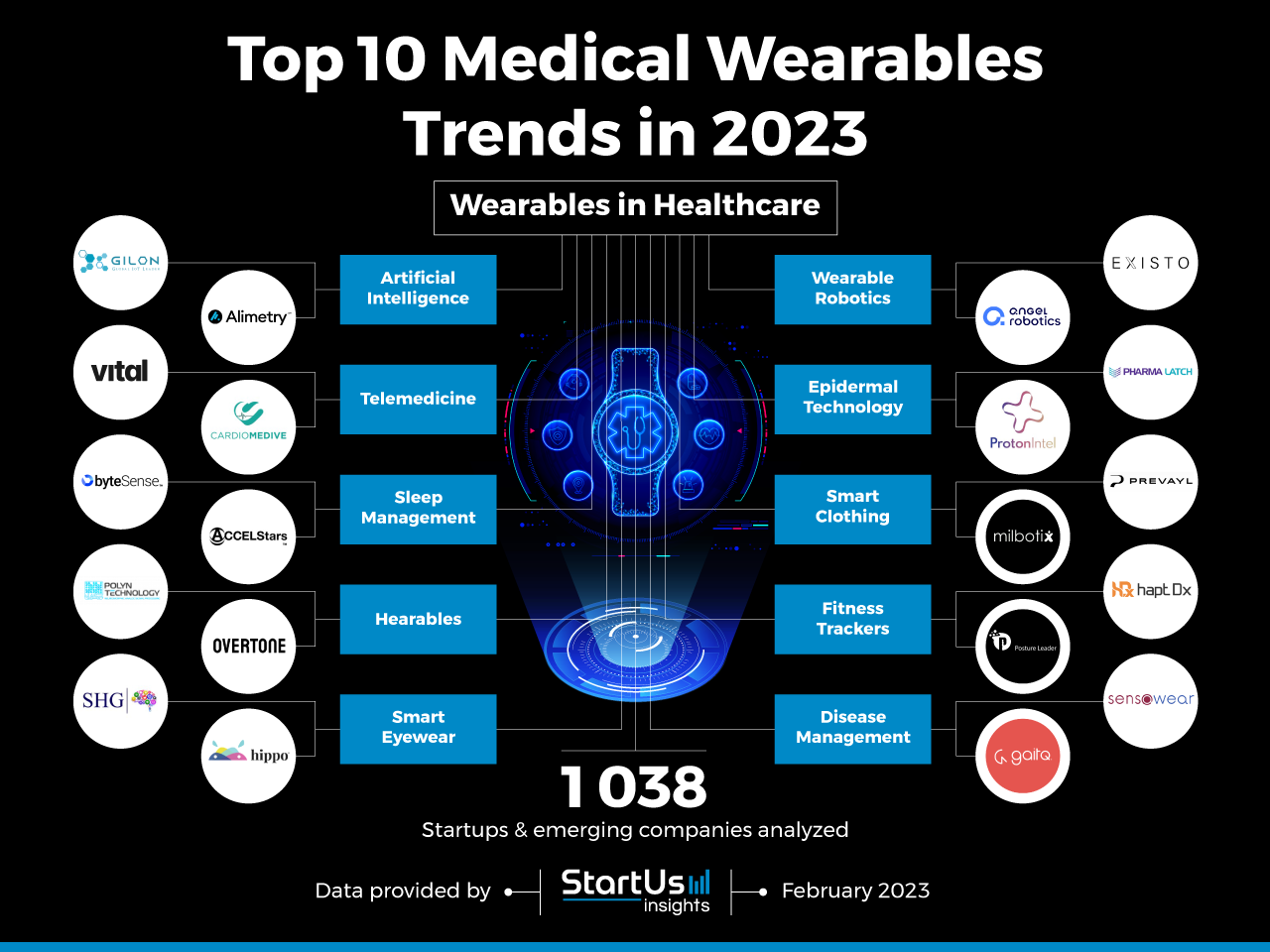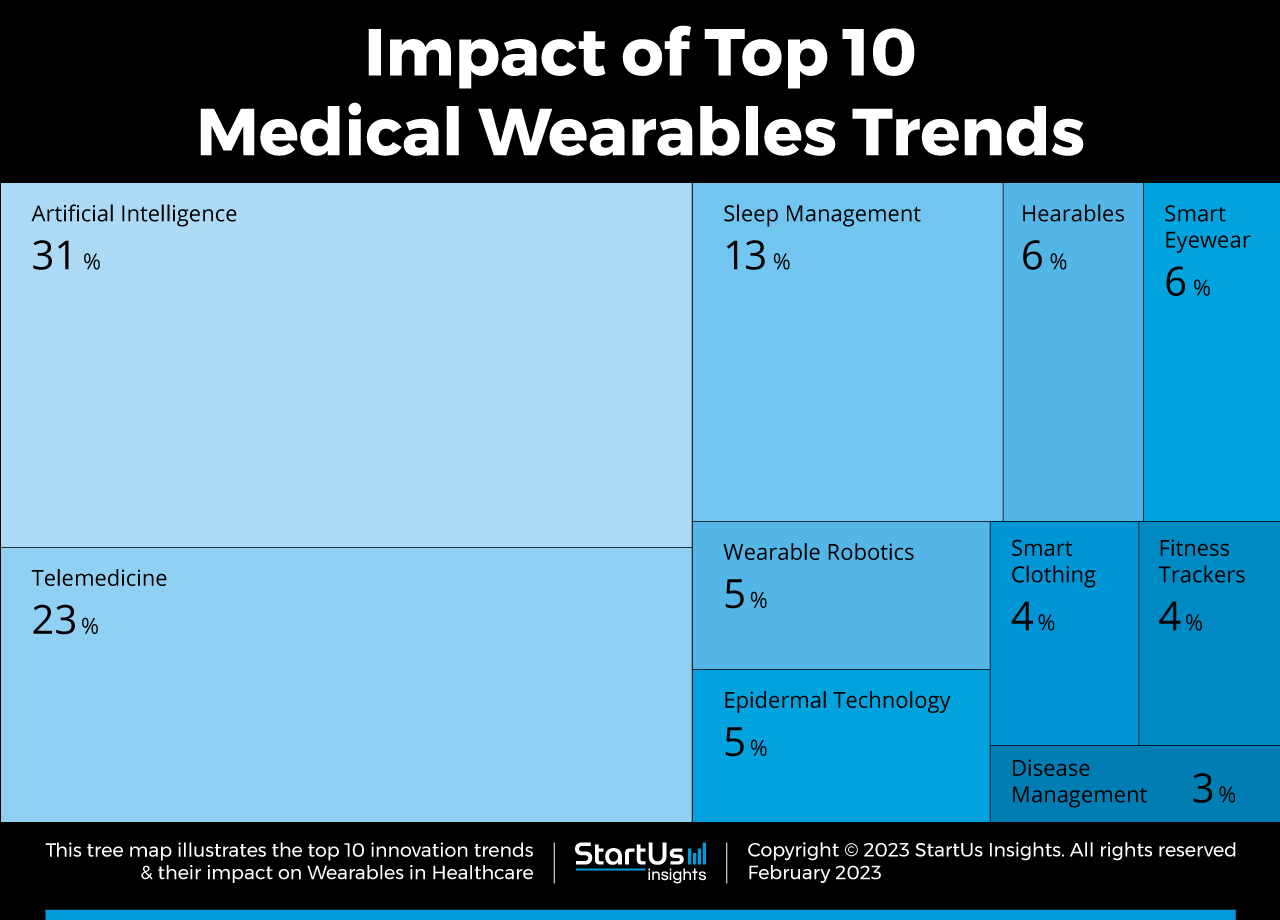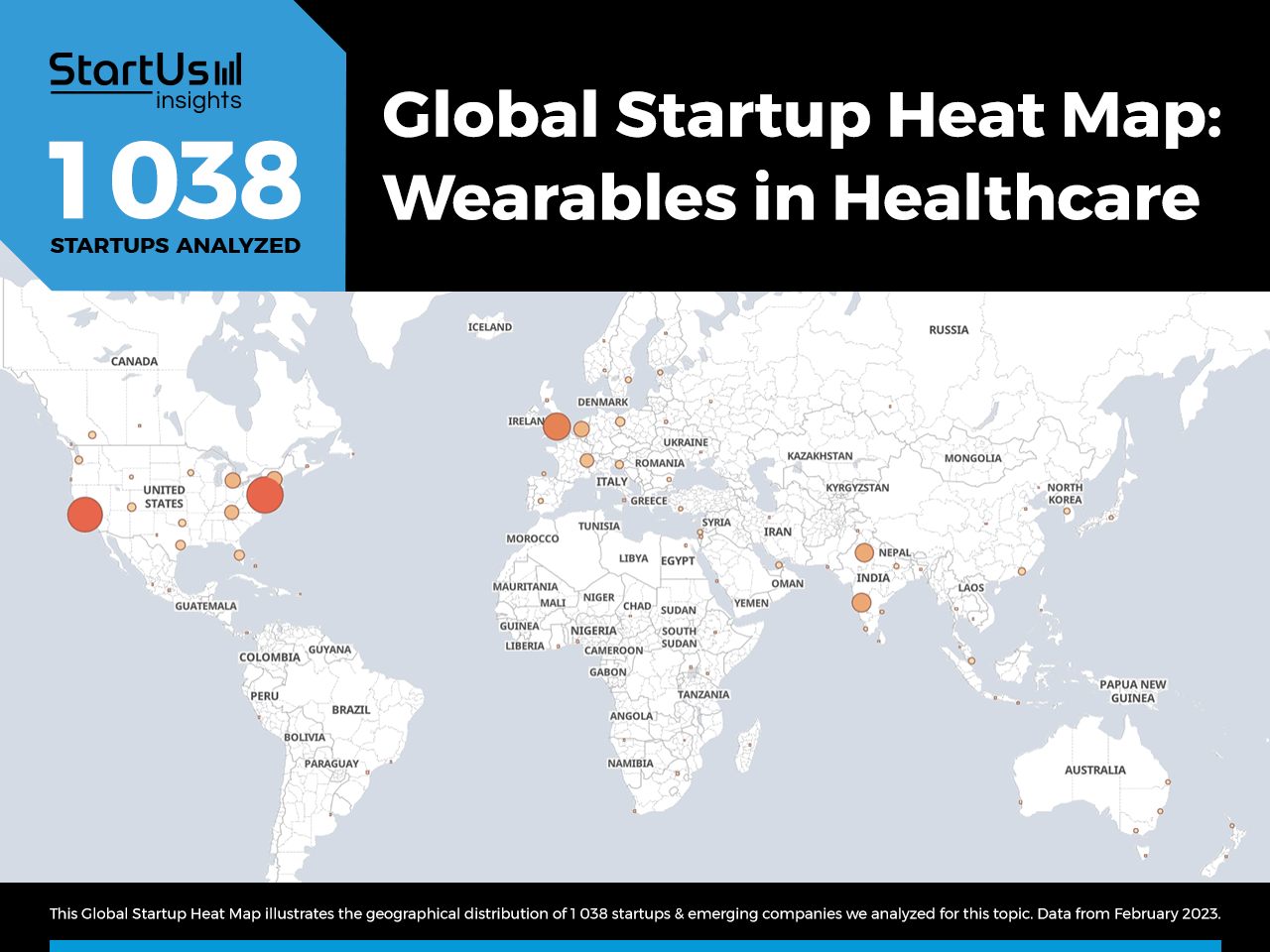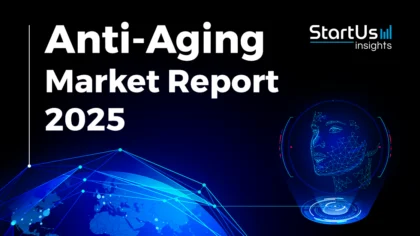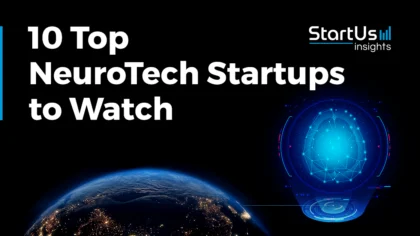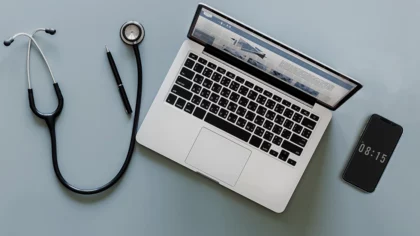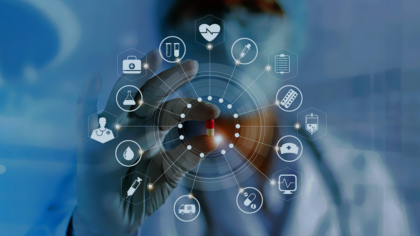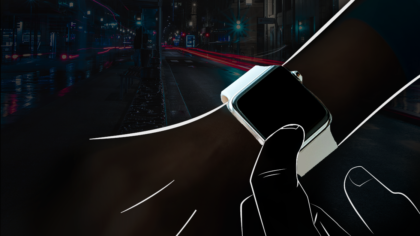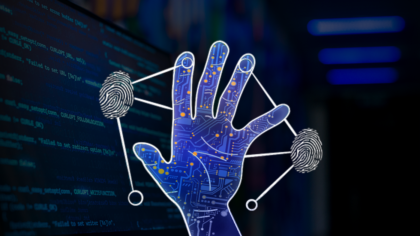Accelerate Productivity in 2025
Reignite Growth Despite the Global Slowdown
Innovations in healthcare wearables enable real-time data collection, activity tracking, condition monitoring, and patient rehabilitation. The integration of medical wearables and technologies, such as artificial intelligence (AI) and robotics, further advances sleep and disease management. Hearables, smart eyewear, epidermal wearables, and other devices improve patient outcomes and quality of life. Startups develop specific sensors for wearables such as accelerometers and optical and bioimpedance sensors. This research provides an overview of the top 10 global medical wearables trends in 2023. Read this report to explore all the trends and discover how they impact your business.
Innovation Map outlines the Top 10 Medical Wearables Trends & 1 038 Promising Startups
For this in-depth research on the Top Medical Wearables Trends & Startups, we analyzed a sample of 1 038 global startups & scaleups. The result of this research is data-driven innovation intelligence that improves strategic decision-making by giving you an overview of emerging technologies & startups in the healthcare industry. These insights are derived by working with our Big Data & Artificial Intelligence-powered StartUs Insights Discovery Platform, covering 3 790 000+ startups & scaleups globally. As the world’s largest resource for data on emerging companies, the SaaS platform enables you to identify relevant startups, emerging technologies & future industry trends quickly & exhaustively.
In the Innovation Map below, you get an overview of the Top 10 Medical Wearables Trends & Innovations that impact 1 038 companies worldwide. Moreover, the Medical Wearables Innovation Map reveals 20 hand-picked startups, all working on emerging technologies that advance their field.
Top 10 Medical Wearables Trends in 2023
- Artificial Intelligence
- Telemedicine
- Sleep Management
- Hearables
- Smart Eyewear
- Wearable Robotics
- Epidermal Technology
- Smart Clothing
- Fitness Trackers
- Disease Management
Tree Map reveals the Impact of the Top 10 Medical Wearables Trends
Based on the Medical Wearables Innovation Map, the Tree Map below illustrates the impact of the Top 10 Medical Wearables Trends in 2023. AI and machine learning (ML) enables automated data collection and real-time analytics, offering personalized care for individuals. Similarly, various types of smart wearables are bringing precision to telemedicine and e-health services. Startups and scaleups in the healthcare industry are also developing intelligent wearable devices that improve sleep management, disease management, and physical rehabilitation. Lastly, amongst the innovative wearable devices, fitness trackers, smart textiles, smart glasses, sub-skin wearable sensors, and hearing aids are the most used.
Global Startup Heat Map covers 1 038 Medical Wearables Startups & Scaleups
The Global Startup Heat Map below highlights the global distribution of the 1 038 exemplary startups & scaleups that we analyzed for this research. Created through the StartUs Insights Discovery Platform, the Heat Map reveals that the US sees the most startup activity.
Below, you get to meet 20 out of these 1 038 promising startups & scaleups as well as the solutions they develop. These medical wearables startups are hand-picked based on criteria such as founding year, location, funding raised, & more. Depending on your specific needs, your top picks might look entirely different.
Top 10 Medical Wearables Trends in 2023
1. Artificial Intelligence
AI-powered platforms and algorithms enhance the accuracy and efficiency of healthcare wearables by providing precise health diagnoses, recommendations, and continuous monitoring. Wearable AI delivers personalized recommendations and predictive analytics for early risk detection. This improves care for general wellness and disease-specific outcomes such as heart attack, diabetes, or strokes. Further, ML algorithms for wearables provide data-driven and error-free vital signs monitoring and medical diagnosis, reducing the need for human intervention. Moreover, startups build natural language processing (NLP) models to extract insights from user behavior and medical data to promptly alert care providers.
Gilon simplifies Disease Prediction
South Korean startup Gilon develops I-SOL, a smart wearable for disease prediction and rehabilitation therapy. It comprises insole-embedded acceleration and pressure sensors to measure outdoor activity. The startup’s platform also utilizes AI algorithms for musculoskeletal disease and activity analysis. This empowers hospitals and remote patient monitoring teams to detect fall accidents and provide corrective rehabilitation training to rehab patients.
Alimetry provides Gastric Motility Diagnostics
New Zealand-based startup Alimetry makes Gastric Alimetry, a non-invasive gastric motility profiling device. It provides a wearable strap to measure gastric activity during fasting and after a test meal as well as a patient-centered app to record symptoms. This data is processed in its cloud platform, Alimetry Cloud, using AI to diagnose gastric neuromuscular dysfunction or provide insights into underlying causes of discomfort. Gastroenterologists use this as a clinical decision support system (CDSS) to identify and reduce trial and error in treatments.
2. Telemedicine
Innovations in wearable devices and the internet of things (IoT) increase precision in remote diagnosis and disease prediction. Remote patient monitoring predominantly relies on wearables to monitor and relay patient data to healthcare providers for analysis, interpretation, and intervention. This decreases hospital visits and mitigates rehospitalizations, thereby reducing the burden on the healthcare infrastructure. Wearables also streamline virtual doctor consultations to provide personalized health advice and automate patient data collection. Startups develop specific wearables to facilitate chronic disease management, such as continuous glucose monitors for chronic diabetes. Similarly, clinics and doctors use wearables for medication management, adherence monitoring, and tracking drug side effects. Many startups are integrating virtual reality (VR) and augmented reality (AR) to improve patient engagement through immersive and interactive experiences.
Vital makes Wearables Application Programming Interfaces (APIs)
Vital is a US-based startup that offers APIs for wearables. The startup’s software development kits (SDKs), drop-in widgets, and webhook integration enable device or stack-agnostic health data collection. Moreover, it provides customizable APIs to develop at-home lab test kits and provides a unified view of the data and insights. This eliminates medical coding and developer costs for wearable and medical device manufacturers as well as diagnostics and telehealth providers.
Cardiomedive facilitates Cardiac Patient Monitoring
Cardiomedive is a Romanian startup that creates a medical-grade electrocardiogram (ECG) patch. It utilizes proprietary LED sensors that record and transfer ECG and photoplethysmography (PPG) data in real-time to the startup’s cloud platform. The platform’s AI algorithms then classify the waveforms to detect different types of arrhythmias. This enables cardiovascular disease management by offering remote screening, diagnostic, monitoring, and telerehabilitation capabilities to healthcare stakeholders.
3. Sleep Management
Healthcare wearables provide a non-intrusive method for sleep analysis and management. Startups develop sleep-tracking devices to continuously monitor sleep patterns, duration, and quality at different stages of sleep. For this, they leverage technologies like ML and big data for automated sleep analysis. Further, wearables detect sleeping disorders such as insomnia, sleep apnea, or narcolepsy to alert healthcare providers for episodic interventions. Sleep trackers also provide personalized guidance to improve sleep quality based on user sleeping patterns and provide reminders to individuals with sleeping disorders. These devices further capture environmental data and other habits such as sleepwalking to identify factors affecting individual sleeping habits.
byteSense develops a Smart Dental Wearable
US-based startup byteSense creates a smart dental wearable device to detect and manage bruxism. The startup’s dental night guard comprises a mouthguard and features in-built sensors, a comfortable form factor, and a wireless charging device. It captures the teeth-grinding patterns of the users while sleeping. The startup’s companion app then provides customized suggestions based on this data.
ACCEL Stars enables Sleep Quality Analysis
Japanese startup ACCEL Stars manufactures proprietary wearable devices for measuring sleep quality. The startup offers integrated software algorithms for accurately detecting wakefulness amidst sleep. This supports the treatment of mental illnesses, diseases of the central nervous system (CNS), as well as developmental and neurodegenerative disorders. Thus, ACCEL Stars enables users to improve sleep quality and also aids in clinical research.
4. Hearables
Hearables or smart hearing devices enable bloodless bio-signal accumulation and vital sign monitoring based on audio and voice interactions. Intelligent earbuds are also utilized for non-invasive hemodynamic monitoring, activity tracking, and speech recognition-based disease management. Doctors, clinicians, and eHealth platforms utilize hearables for sleep monitoring as well as anxiety and depression diagnosis using speech analysis. Many health applications also integrate hearables with their platforms to provide virtual coaching, consultations, and therapies for various physical and mental health issues.
POLYN Technology develops AI Chips for Hearables
Israeli startup POLYN Technology manufactures NeuroVoice, an ultra-low power tiny-AI chip for hearables. It leverages neuromorphic analog signal processing (NASP) and provides cloud-agnostic, low-latency, and active voice extraction in noise environments for voice processing. Additionally, NeuroVoice offers voice features such as keyword spotting, voice activity detection, and wake word recognition. Manufacturers of earbuds, smartphones, hearing aids, and intercom systems use it to enable always-on operation with improved battery life.
Overtone offers Hearing Aids
German startup Overtone develops medical-grade hearing aids for enhancing real-world sounds for people with hearing disabilities. The startup’s hearables and smartphone app create personalized hearing profiles for users by measuring their sensitivity to different frequencies. The hearing aids then utilize the profiles to enhance the frequencies of complex sounds to make their hearing clearer. The startup’s hearing technology thus offers improved hearing assistance for longer durations along with a Bluetooth-connected entertainment experience.
5. Smart Eyewear
Smart eyewear or glasses monitor wearers’ health information through visual and audio interactions. Startups develop smart glasses for remote vital signs monitoring, virtual consultation, and medical diagnosis. Smart vision glasses now also support medication management, electronic medical record (EMR) management, hands-free documentation, and medical training. Innovative smart glasses include AR and VR to deliver an immersive and engaging patient experience. They enhance medication adherence, enable real-time tracking of side effects, and offer language translation to serve non-English speaking patients. These innovations improve the accessibility, convenience, and effectiveness of healthcare systems while reducing the cost of medical operations.
SHG Technologies offers a Smart Vision Glass
Indian startup SHG Technologies builds a smart vision glass for the visually impaired. It combines AI, machine vision, a camera, LiDAR, a proximity sensor, and braille-coded touch keys. AI and machine learning assist wearers while walking, reading, and for identification of objects and people. People suffering from blindness, macular degeneration, diabetic retinopathy, cataract, and other visual impairments are prescribed the startup’s smart glass as an assistive wearable device.
Hippo Technologies enables Virtual Consultation
US-based startup Hippo Technologies provides Hippo SPX, a voice-activated headset for virtual collaboration. It connects with existing medical systems and IoT devices as well as leverages two high-resolution cameras. The headset also features hands-free intuitive voice controls. Its clinical decision support and AR display capabilities enable remote consultations, training, medical equipment maintenance, and surgeries, among others. Clinicians and surgeons use it for real-time specialist consultations and for emergency management.

6. Wearable Robotics
Wearable robotics or exoskeletons in healthcare support physical rehabilitation for people with impairments or disabilities, eliminating provider assistance. It addresses the lack of medical staff and aids mobility assistance for people with spinal cord injuries, stroke, and other conditions. Startups provide rehabilitation exoskeletons for strength and mobility training after surgical interventions or injuries. Conditions such as cerebral palsy, Parkinson’s disease, etc. require gait training using wearables to improve cognitive control of motor functions. Similarly, wearable robotics are increasingly used as assistive technology for the elderly, empowering them to be more independent. These innovations further facilitate the personalization of therapeutics and rehabilitation, leading to improved patient outcomes and care delivery.
Existo develops a Robotic Grasping Device
Italian startup Existo makes a wearable robotic grasping device to augment the abilities of hands. It functions as a robotic finger and is wearable on any part of the arms to perform gripping actions. This imparts continuous motor rehabilitation by triggering new cognitive functions in patients’ disabled limbs. The device also finds use in physio and occupational therapies as well as post-acute and chronic paralysis rehabilitation.
Angel Robotics offers Gait Training Exoskeleton
South Korean startup Angel Robotics manufactures wearable robotic exoskeletons for gait training. The startup’s motorized gait training robot, Angel Legs M20-A, analyzes the rehabilitation of patients with lower extremity paralysis. It then assists the muscular force of wearers and uses the neuro-muscular system to adapt the assistance as per user intention. Rehabilitation therapists and clinicians use these exoskeletons for designing gait training programs and patient improvement analysis.
7. Epidermal Technology
Epidermal wearables enable patient health monitoring and chronic patient management. Subskin sensors monitor parameters such as heart rate, temperature, and blood pressure and relay the data for real-time analysis and timely intervention. Startups develop implantable biosensors, wearable injectors, and dermal patches that streamline medication management, enable injection on-demand, and provide deep tissue biometrics. Dermal sensing devices also measure skin vitals and advance dermatological diagnosis and therapeutics. Innovations in epidermal technology enhance the accessibility to wellness and simplify continuous monitoring.
Latch Medical designs a Drug Delivery Patch
Irish startup Latch Medical develops Pharma Latch Coated, a microneedle array for self-administered intradermal drug delivery. It is coated with dry compound coatings that release upon exposure to the moisture of the skin. The array’s non-adhesive, click-on, click-off mechanism facilitates high and consistent payload dosing penetrating the stratum corneum, enabling sustained drug release. Similarly, it also develops another solution, Pharma Latch Hollow, for intradermal delivery of liquid drugs and vaccines. The startup’s products improve dose efficiency and immune response while minimizing reliance on cold chain logistics for pharmaceutical research and drug companies.
ProtonIntel accelerates On-demand Biomarker Monitoring
Canadian startup ProtonIntel develops a continuous potassium monitoring wearable device. It checks potassium levels and provides insights through its app. This enables on-demand monitoring of potassium and equips clinicians in managing hyperkalemia, and preventing chronic kidney diseases and heart attacks.
8. Smart Clothing
Startups integrate sensors in textiles and clothing for non-invasive health data collection without interrupting wearer activities. Smart clothing, including shirts, vests, socks, and undergarments, provides data on vitals and environmental factors that influence wearers’ health. Fabrics embedded with sensors for electrocardiography (ECG) monitoring detect arrhythmias and other cardiovascular diseases and reduce episodic occurrences of fatal events. Some common applications of wearable textiles also include sleep monitoring, posture correction, wound healing, and smart bandages. Moreover, startups now develop face masks that detect air quality and alert the user of potential hazards and precautions. Healthcare providers further utilize connected clothes to advance telehealth and remote patient care.
Prevayl makes Connected Apparel
UK-based startup Prevayl manufactures smart clothing solutions with connected sensors that provide insights into wearers’ health. The startup offers e-textiles for real-time monitoring of biometric, fitness, and cardiovascular health data, as well as data from training and workouts. This enables healthcare providers to develop purpose-driven products for data-driven and personalized care experiences.
Milbotix provides a Smart Sock
UK-based startup Milbotix develops a smart sock to measure anxiety and stress levels in patients with communication difficulties. It consists of an embedded sensor that collects physiological data from wearers’ foot and ankle movements. This sensor data is processed on the startup’s cloud-based platform to detect and alert patient distress levels. Nursing homes and home care providers use it to assist patients suffering from dementia, autism spectrum disorders, and learning disabilities.
9. Fitness Trackers
Fitness and wellness trackers drive general and clinical care while improving accuracy in remote patient care and telemedicine. Besides monitoring physical activities, calories burned, and distance traveled, they provide tailored feedback to improve fitness. Heart rate monitoring, sleep analysis, stress management, and nutrition tracking are a few medical applications of such fitness trackers. These trackers usually come with companion smartphone apps that provide personalized coaching and health education. Examples of fitness trackers include smart bands, smartwatches, and smart scales, among others, which provide data-driven feedback. Some startups also provide gamification and social connectivity to improve patient engagement and interaction. Fitness trackers remove the data silos in traditional healthcare and provide location-agnostic care.
Haptic Diagnostics enables Continuous Glucose Monitoring
Bahraini startup Haptic Diagnostics builds haptDx, a wearable for real-time monitoring and communication with medical devices. The product’s wearables strap is worn on the inner forearm and uses haptic technology to deliver diagnostic information from continuous glucose monitors (CGM). It uses electro-tactile pads to deliver the signal patterned for different results and alerts the users. This enables diabetes and wellness management while relaying health information discreetly and without interrupting user activity.
Posture Leader provides a Posture Correction System
Canadian startup Posture Leader offers a smart posture correction system for dentists. It utilizes a wearable spine sensor, a dental unit anchor, and an AI-powered mobile application to apply gesture recognition and detect improper postures. The dental unit measures inertial movements for indoor localization while the app delivers real-time alerts for continuous bad postures. Dental practitioners use it to prevent musculoskeletal disorders (MSDs) arising from incorrect postures.
10. Disease Management
Chronic disease management involves patient self-care protocols where healthcare wearables improve medication adherence. They reduce the burden on hospitals and medical infrastructure as well as decrease hospital readmission rates and improve patient life expectancy. Startups use sophisticated biosensors, AI memory chips, and a range of connected wearable devices that feature edge processing capabilities. This reduces the time required to accurately diagnose health conditions and empowers care teams to adapt the treatment protocols efficiently. These devices also integrate with electronic health records (EHRs) to offer a 360-degree view of patient health, improving care delivery.
Sensawear simplifies Post-Operative Patient Monitoring
Swiss startup Sensawear makes a textile-based tissue health monitoring system. It features near-infrared spectroscopy (NIRS) technology to determine deep tissue oxygen saturation (StO2) levels and pressure injuries. When low oxygen levels are detected, its sensor alerts the care providers to move the patients and prevent pressure ulcers. This enables non-invasive pressure injury prevention in post-operative patient monitoring, geriatric clinics, and neurological rehab centers.
gaitQ facilitates Parkinson’s Management
UK-based startup gaitQ facilitates Parkinson’s disease management through gait data analysis. The startup’s wearable device controls freezing and adapts to patients’ pace. It then provides smart cueing that ensures a stable gait without manual readjustments. Further, its proprietary portal allows medical professionals to distinguish critical points in disease progression and personalized exercise programs. This enables medical professionals to improve treatment protocols and better manage Parkinson’s disease on an individual level.
Discover all Medical Wearables Trends, Technologies & Startups
Startups and scaleups are incorporating advanced sensors that measure a wide range of biometric information in smaller form factors. This leads to the miniaturization of wearable devices, eventually making them discreet and more convenient for wearers. Leveraging 5G networks further enable features such as low-latency live monitoring and remote consultations. Startups are integrating blockchain for secure and anonymous patient data storage and sharing. Similarly, adaptive wearables adjust to the wearers’ needs and accelerate personalized medicine. These innovations significantly impact healthcare and wellness in the coming years and will significantly improve quality of life.
The Medical Wearables Trends & Startups outlined in this report only scratch the surface of trends that we identified during our data-driven innovation & startup scouting process. Among others, fog computing, edge AI, and blockchain will transform the sector as we know it today. Identifying new opportunities & emerging technologies to implement into your business goes a long way in gaining a competitive advantage. Get in touch to easily & exhaustively scout startups, technologies & trends that matter to you!
